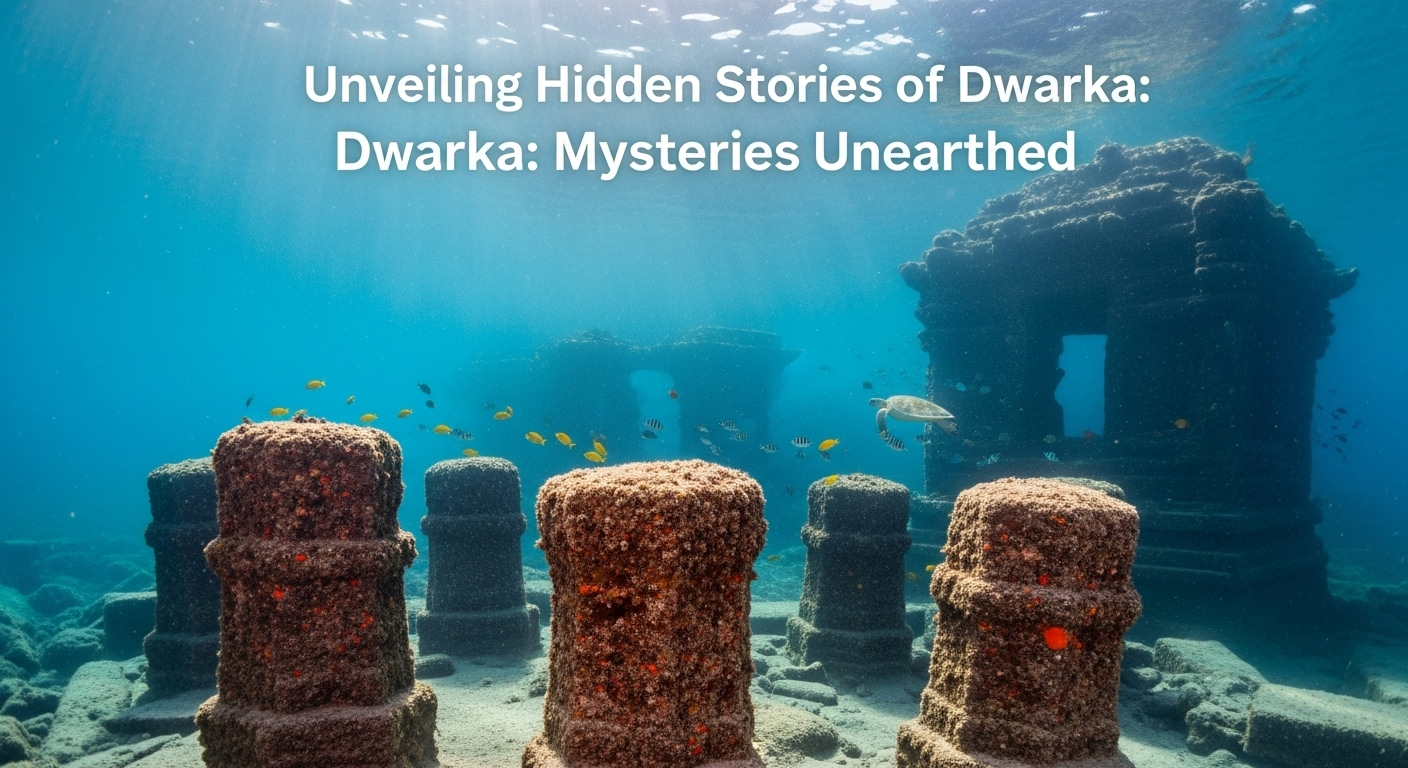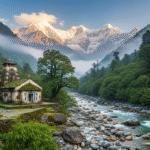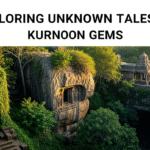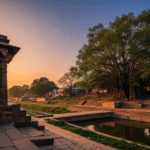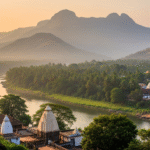Far below the Arabian Sea, near India’s western coast, lies an ancient city. This city, Dwarka, remains hidden under the sea for thousands of years. People think it’s the kingdom of Lord Krishna. It showed itself with old treasures dating to 1500 BCE. In 1979, marine archaeologists found it deep underwater. They discovered a long wall, pillars, and pottery, showing how important Dwarka was in history.
Explorers dive deep to uncover Dwarka’s secrets, finding things older than the famous Indus Valley. The ocean hid this city, but its stories are coming back through exploration. They find treasures and structures down to 40 meters deep.
Dwarka’s history is about its past glory and natural changes. It talks about rising sea levels, land moving, and the sea’s currents. These things changed the coastline and hid the city under the sea.
Now, with new tech, we can explore Dwarka’s underwater secrets from anywhere. This tech lets us create 3D models and virtual tours. So, anyone can see the wonders of this sunken city.
Key Takeaways
- Dwarka’s mysteries unravel through ongoing maritime archaeological explorations.
- Ancient structures and artifacts submerged near Dwarka reflect a potent maritime trade network.
- Shifts in the earth’s crust and rising sea levels are key factors in the historical submergence of coastal cities.
- Technological advancements are pivotal in bringing the hidden stories of Dwarka to a global audience.
- The potential for underwater tourism in Dwarka invites parallels to other internationally recognized submerged heritage sites.
- Embracing cutting-edge technology may unlock further historical insights into Dwarka’s sunken wonders.
The Spiritual Epicenter: Dwarka’s Mythological Origins
Dwarka is full of spiritual stories and important history. It is known as a place of worship. Its stories come from Hindu books. Lord Krishna started this holy place. It’s for those going on religious trips and those seeking spiritual peace.
The Kingdom of Lord Krishna
Dwarka was a big kingdom with Lord Krishna in charge. Vishwakarma, the god’s builder, made it. It was stunning, with big palaces and lots of gold and jewels. The city is famous for spirituality and old battles. This keeps people talking about Dwarka today.
Descriptions in Ancient Scriptures
The Mahabharata talks about Dwarka’s beauty. It shows Lord Krishna’s greatness. The writings talk about its buildings and important history. This makes Dwarka interesting for believers, historians, and researchers. They study old things found there.
The Submersion of Dwarka in Texts
Books say Dwarka sank into the sea after Lord Krishna left the earth. After his death, a huge flood destroyed the city. This mystery makes people want to find the sunken Dwarka.
Dwarka’s story mixes real history with myths. This is fascinating to many people. Today, not only pilgrims visit, but also archaeologists. They want to learn more using new digging methods.
Archaeological Breakthrough: Discovering Dwarka’s Underwater Remnants
The quest to find the legendary underwater city of Dwarka advanced greatly in the 1980s. Marine archaeologists like S. R. Rao led this effort. They found remains off India’s western coast, which match ancient stories of a city lost to the sea. These discoveries have fascinated historians and sparked worldwide interest in the ocean’s secrets.
They found many underwater structures showing a large city once stood there. These structures, like pillars and breakwaters, span over half a mile. They sit forty meters below the sea, showing us a city that was buzzing with life long before our oldest stories.
The recovered artifacts tell us about the people who lived in Dwarka. We found pottery, sculptures, and ancient coins. There’s even a stone slab with writing from long ago, showing a culture rich in writing and administration.
Radiocarbon dating of these artifacts shows they are from around 7500 BCE. This is way older than what many historians thought. It makes us rethink history and how advanced ancient cities like Dwarka were.
Today, modern technology and traditional methods are uncovering more about Dwarka beneath the sea. Every dive brings myth and reality closer together. We get a peek at a vibrant city now quiet under the Arabian Sea. The tale of Dwarka, blending spirituality, strength, and science, remains an exciting mystery in underwater archaeology.
Scientific Investigations into Dwarka’s Demise
Scientists are looking deeper into why Dwarka sank beneath the Arabian Sea. This ancient city is full of history and myths. Studies focus on natural causes for its disappearance, not just old tales.
The Role of Tectonic Shifts
Dwarka was near the moving plates of Earth’s crust. This area is known for earthquakes. Tectonic shifts might have made parts of the city fall into the sea. Experts from the Dwarka excavation say earthquakes caused the city to sink. The ground also sank slowly over time. This helps us understand Dwarka’s fate better.
Sea Level Changes and Coastal Erosion
After the last Ice Age, sea levels went up. This rise could have covered Dwarka. Coastal erosion also played a part. The sea’s currents wore down the coasts protecting the city. Research is still going on about how these factors combined to drown Dwarka.
Learning from the Dwarka digs teaches us about Earth’s changes and our history. It shows how nature and human stories are linked. These discoveries make us rethink old city legends. They show why Dwarka’s story is important for science and history.
Modern Exploration of the Hidden Stories of Dwarka
People are using myths and high-tech underwater archaeology to explore Dwarka. The ancient sunken city shows us amazing things about past human lives. This has made more scientists want to study it lately.
Marine Archaeology’s Advancements
Marine archaeology has grown thanks to new tools. Devices like ROVs and advanced sonar let scientists go deeper into the sea. Because of these tools, they can find, map, and study ancient structures more easily.
They can now safely bring up artifacts for a closer look. These technologies have helped us learn a lot. They show us how people in the ancient city around 1500 BCE lived their daily lives.
Technological Tools in Unearthing History
Technology has changed how we explore the underwater city of Dwarka. With 3D modeling and special software, people can see the city in great detail. This lets everyone, not just experts, see the ancient ruins without harming them.
https://www.youtube.com/watch?v=bTnUE_f_piM
This progress means we might find even more in the future. It could give us more clues about Dwarka’s history and culture. As marine archaeology gets better, Dwarka’s story keeps intriguing everyone, from historians to those who love mysteries.
Myth Meets Reality: Aligning Legendary Narratives with Archaeological Evidence
The Dwarka legend fascinates many. It mixes myths with real evidence. The Dwarka archaeological discoveries make old stories seem real. They link ancient texts to things we can touch.
The Dwarka myth and real discoveries fit together well. Underwater explorations found buildings like those in old stories. These stories said Dwarka was a big city ruled by Lord Krishna. Finding these remains changes stories into history we can prove.
The task of matching myth with truth tells us more about Dwarka’s history. It makes us rethink old myths as possible truths. As we find more evidence, both scholars and archaeologists get new clues for exploration.
Studying these finds shows how important it is to combine different sciences. It also shows how technology helps us find out about the past. Techniques like carbon-dating and underwater archaeology give us a clearer view of ancient Dwarka. They match the old Dwarka legends.
The move from myth to history is hard. But Dwarka’s discoveries are key in archaeology. They blend stories with artifacts to light up lost civilizations’ histories. Dwarka’s story improves our global understanding of preserving heritage. It pushes archaeology’s limits in uncovering our collective history.
The Enigma of Accessing Dwarka’s Underwater City
People have long been fascinated by the Dwarka underwater city. It holds secrets from ancient times. It shows us how old cities were planned and linked to their cultures. But, getting to this underwater wonder is tough. There are strict rules to keep it safe.
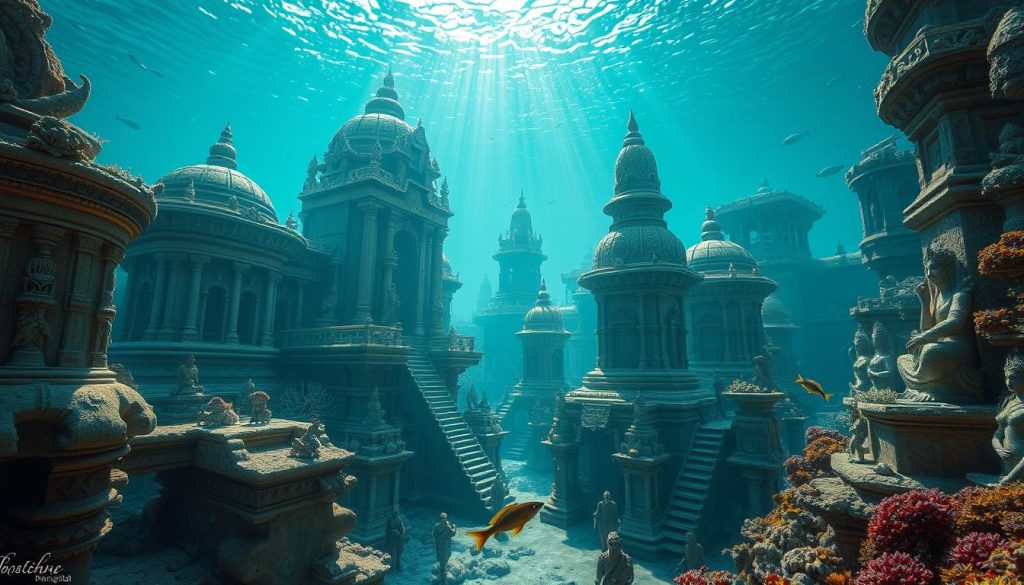
Explorations of the underwater city show us big structures below the water. They tell us about a grand city with advanced buildings. But, a team watches the site to stop damage from too much diving.
Current Challenges and Regulations for Divers
Not everyone can go to the Dwarka underwater city. There are strong rules to follow. Only trained marine archaeologists and some researchers can dive here. They use special gear. This keeps the site’s history safe while they study it.
Preservation Efforts of Submerged Heritage
Keeping submerged heritage at Dwarka safe is very important. It’s about protecting the site and the things found there. Many groups work together on this. They use special methods to stop the remains from getting worse.
| Year | Discovery | Impact on Submerged Heritage Preservation |
|---|---|---|
| 1980s | Discovery by S.R. Rao | Confirmed historical basis for legends, increased focus on preservation methodologies |
| 2007 | Large stone structure found underwater | Reignited comprehensive exploration and preservation efforts |
| Present | Ongoing research and restricted dives | Enhanced protective regulations to safeguard the submerged structures and artifacts |
The Dwarka underwater city is very important for more than just archaeology. By keeping this ancient city safe, we protect a part of human history. This could change our view of ancient times. Our work not only secures our history but also makes sure future generations can learn from these underwater findings.
Dwarka’s Cultural Resonance in Contemporary India
The sacred city of Dwarka is very important in Hindu culture. It continues to be a key spot for spiritual journeys and cultural expressions today. The Dwarkadhish Temple is at the heart of this culture. It is a place of devotion that draws people from all over the world. This site perfectly mixes old stories and today’s spiritual practices.
The Pilgrimage Experience at Dwarkadhish Temple
The trip to Dwarkadhish Temple is life-changing. Many Hindu devotees visit every year. They come to experience the temple’s magical feel. This journey connects the city’s ancient history with its spiritual present. Every step towards the temple takes you back in time. It also shows the city’s ongoing link to Krishna’s teachings.
Significance for Hindu Devotees
The Dwarkadhish Temple means more than just its stunning looks. It makes a strong bond with believers through its history and religion. For those following Hinduism, it is a key place. It’s where Lord Krishna’s lessons are felt through time. Visiting the temple is a personal and cultural moment, key to Hindu worship today.
| Festival | Activities | Impact on Devotees |
|---|---|---|
| Janmashtami | Midnight Aarti, Bhajans | High emotional and spiritual engagement |
| Diwali | Lights, Offerings, Prayers | Renewed spiritual vows and community bonding |
| Holi | Flower Holi at the temple | Lively participation reflecting Krishna’s playful aspects |
| Navratri | Nine nights of dance and worship | Intense devotion and display of cultural heritage |
Through these rituals and festivals, Hindu devotees celebrate and strengthen their ties to Krishna’s teachings and Dwarka’s history. Each festival at the temple turns into a colorful showcase of living history and spiritual energy in Dwarka. It makes it an essential part of India’s cultural story.
Dwarka’s Place in India’s Maritime History
Dwarka’s ancient city has a storied past. It has long interested scholars and historians. This is because it was part of a big maritime trade network that linked it with other coastal places.
Through dedicated underwater archaeology, more proof has been found. This proof cements Dwarka’s spot in India’s ancient maritime history.
Signs of Ancient Trade and Urban Planning
In 1983, the National Institute of Oceanography (NIO) did some digging. They found structures under the sea near Dwarka. These finds tell us about a well-planned city that was big on sea trade.
The discoveries include stone walls, foundations, and pillars. They are up to 40 meters under the sea. These suggest smart urban planning for a bustling trade center.
Linkages with Other Coastal Civilizations
The things found like pottery, tools, and stone anchors show busy economic life. These items connected Dwarka to other ancient coastal places. They helped in cultural exchanges and economic ties.
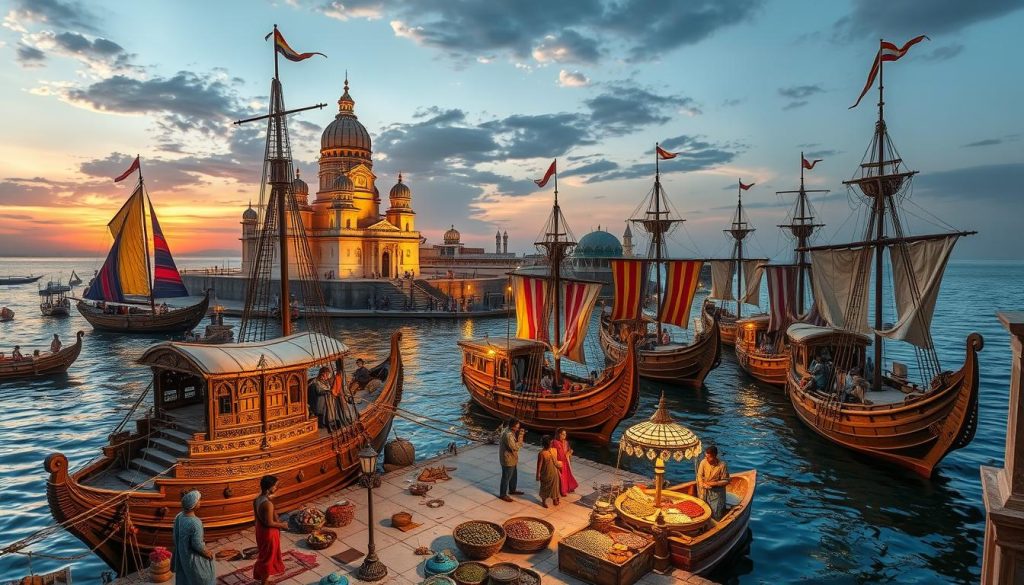
We learn more about Dwarka’s maritime roles through these finds. The items found hint at talks between different communities. Some were nearby, others might have been far, across the Arabian Sea.
| Material Found | Implication | Presumed Era |
|---|---|---|
| Stone anchors, pottery | Indicative of extensive sea trade | 1500 BCE |
| Walls, pillars, foundations | Evidence of urban planning | 1500 BCE |
| Underwater stone structures | Similarities with other ancient sites | Varied timelines |
The discoveries at Dwarka highlight its rich history and culture. They also show how its society was advanced. This society could handle a large maritime trade network well.
Hidden stories of Dwarka: Legends and Local Lore
In the heart of India’s myths, the ancient city of Dwarka stands. It is full of mystery and has deep Dwarka legend. From Lord Krishna’s stories to its sinking tales, Dwarka myth captures many hearts. These stories are key to India’s culture. They are shared from one generation to the next, keeping local lore alive.
These legends are not just tales. They connect us to our past. They blur history and mythology. Many revere this city, holding the Dwarka legend dear. It symbolizes victory and enlightenment.
| Legend Component | Description | Cultural Significance |
|---|---|---|
| Krishna’s Dwarka | The city as the realm of Lord Krishna, described opulently in sacred texts. | Reflects the divine and moral framework within Hindu philosophy. |
| Submerged City | Stories of the city’s submersion post-Krishna’s era, a testament to the cycles of time. | Symbolizes the transient nature of human constructs in the face of nature’s eternal rule. |
| Spiritual Pilgrimage | Dwarka as a still-thriving pilgrimage site attracting millions yearly. | Shows the unbroken continuity of devotional practice and its modern-day relevance. |
Dwarka is a treasure of history and faith. It brings together scholars and the faithful. The mix of Dwarka myth and local lore makes a special story. This keeps the city’s legendary status in Indian culture.
Future Implications: Tourism and Preservation of the Underwater Site
The sunken city of Dwarka brings challenges and chances in heritage tourism and underwater site preservation. New tech and archaeology are merging. They bring advanced ways to see and enjoy these underwater places safely, like through virtual reality in archaeology.
The Balance between Exploration and Conservation
To keep Dwarka’s underwater sites safe, we need to find a balance. The area is old, dating back to 1500 BCE. It has artifacts from an ancient trade network. We must make rules to protect it from too much human activity.
Many people come to dive and snorkel around Dwarka. This shows why we need careful ways to let people visit but still protect the site.
Virtual Reality and Its Role in Heritage Tourism
Virtual reality in archaeology is a great way to let more people see underwater sites. This tech causes less harm. It also allows people everywhere to see Dwarka’s wonders without damaging the site.
| Site Name | Description | Significance |
|---|---|---|
| Bhadkeshwar Mahadev Temple | Temple mostly underwater; visible during low tides. | Spiritual site with visible submerged structures, enhancing the mystique of Dwarka. |
| Okha Port | Active fishing port with a vibrant market. | Displays the living maritime heritage and bustling economy of Dwarka. |
| Gopi Chandan Site | Site for collecting sacred yellow sand. | Connects visitors with the traditional and religious practices tied to Lord Krishna. |
To safely let people visit underwater sites like Dwarka, we need to spend money. We have to build things and make rules. This way, we keep the site safe and its surroundings healthy. As tech for exploring underwater gets better, we might find more ruins. This could let more people learn about our underwater history.
Conclusion
The tale of Dwarka is a mix of culture and spirit that fascinates people. It has been so for many years. This city under the sea has a history that goes beyond any story. It is real and full of discoveries. People who study the past work hard to learn its secrets. They use new tools and ways to learn. What we once thought was just a story is now shown to be true by what we find under the water.
Dwarka is important for many reasons. It touches the hearts of many people today. Some feel a spiritual connection. Others are simply amazed by the story of this ancient city. The tale of Dwarka, with its underwater ruins, shows us the skills and deep spirit of long ago. The stories of Lord Krishna’s kingdom make us wonder. The ruins under the sea make those stories feel real. So, Dwarka keeps being important for study, travel, and saving history.
In the future, how we save history and explore will shape how we learn more about Dwarka. Every old thing we find and every building we understand adds to its story. This adds to the big story of India’s history. Dwarka brings together its old stories and what we hope to learn. Each new discovery makes us understand more about this amazing place and why it draws us in.
FAQ
What are the hidden stories of Dwarka?
Dwarka’s hidden tales come from ancient Hindu stories. It was Lord Krishna’s kingdom, a splendid city now under the sea. People explore this mysterious underwater city through stories and science. They look for its secrets with discoveries and investigations.
What does mythology say about the ancient city of Dwarka?
According to myths, Dwarka was a magnificent city built by divine architect Vishwakarma for Lord Krishna. It had palaces of gold and silver and lovely gardens. After Krishna left the earth, the sea swallowed the city.
What have the archaeological discoveries revealed about Dwarka?
Scientists found underwater ruins in the Gulf of Khambhat. They saw old stone buildings, pillars, and walls. Found pottery and tools show a key port city from before 1500 BCE.
How do scientists explain the submersion of Dwarka?
They say natural events like earth shifts and the end of the Ice Age made seas rise. Sea currents also eroded the coast. These reasons caused Dwarka to sink over time.
What advancements have been made in the modern exploration of Dwarka?
New tech like underwater robots and sonar have helped study Dwarka’s ruins. Archaeologists use these tools to learn about the sunken city. They apply new research methods to understand the site better.
How do mythological texts compare with the archaeological evidence found in Dwarka?
Linking mythology with ruins gives a better picture of Dwarka’s past. The actual ruins match the legends. This makes people excited about the city Lord Krishna ruled.
What are the challenges in accessing the underwater city of Dwarka?
Only expert archaeologists can explore Dwarka’s ruins due to rules that protect the site. Divers can only visit nearby waters. They need special permission to see the ancient ruins.
What significance does the Dwarkadhish Temple hold in contemporary India?
The Dwarkadhish Temple draws pilgrims from around the world. It shows India’s holy and cultural past. The temple and the legendary sunken city give pilgrims a deep feeling of respect and faith.
How did Dwarka play a role in ancient maritime trade?
Found artifacts show Dwarka was a big trade center. It was an important part of sea trade long ago. This highlights its role in ancient Indian maritime history.
What local lore exists about Dwarka?
Dwarka has many local tales that blend history with legend. These stories, along with tales of Krishna, keep the city’s story alive in our hearts.
What future implications exist for tourism and preservation of Dwarka’s underwater site?
The future of Dwarka’s site is finding a balance between exploring and saving it. New technology could let more people see the site safely, without damaging it.
